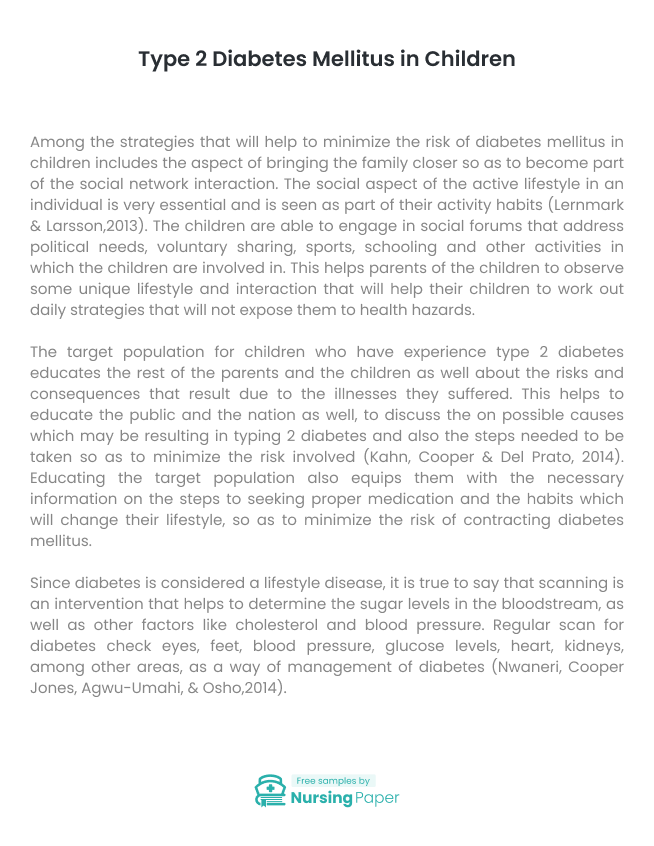1. Balaji, V., Balaji, M.S., Datta, M., Rajendran, R., Nielsen, K.K., Radhakrishnan, R., Kapur, A. and Seshiah, V., 2014. A cohort study of gestational diabetes mellitus and complimentary qualitative research: background, aims and design. BMC pregnancy and childbirth, 14(1), p.378.
2. Cheng, L., Sit, J.W., Choi, K.C., Chair, S.Y., Li, X. and He, X.L., 2017. Effectiveness of Interactive Self‐Management Interventions in Individuals With Poorly Controlled Type 2 Diabetes: A Meta‐Analysis of Randomized Controlled Trials. Worldviews on Evidence‐Based Nursing, 14(1), pp.65-73.
3. Dunkley, A.J., Bodicoat, D.H., Greaves, C.J., Russell, C., Yates, T., Davies, M.J. and Khunti, K., 2014. Diabetes Prevention in the real world: Effectiveness of pragmatic lifestyle interventions for the prevention of type 2 diabetes and of the impact of adherence to guideline recommendations. Diabetes care, 37(4), pp.922-933.
4. Hannon, T.S., Carroll, A.E., Palmer, K.N., Saha, C., Childers, W.K. and Marrero, D.G., 2015. Rationale and design of a comparative effectiveness trial to prevent type 2 diabetes in mothers and children: The ENCOURAGE healthy families study. Contemporary clinical trials, 40, pp.105-111.
5. Kahn, S.E., Cooper, M.E. and Del Prato, S., 2014. Pathophysiology and treatment of type 2 diabetes: perspectives on the past, present, and future. The Lancet, 383(9922), pp.1068-1083.
Lernmark, Å. and Larsson, H.E., 2013. Immune therapy in type 1 diabetes mellitus. Nature Reviews Endocrinology, 9(2), pp.92-103.
6. MacMillan, F., Kirk, A., Mutrie, N., Matthews, L., Robertson, K. and Saunders, D.H., 2014. A systematic review of physical activity and sedentary behavior intervention studies in youth with type 1 diabetes: study characteristics, intervention design, and efficacy. Pediatric diabetes, 15(3), pp.175-189.
7. Nwaneri, C., Cooper, H., Jones, D.B., Agwu-Umahi, O. and Osho, T., 2014. Measure of the Rate at which Mortality in Type 2 Diabetes Mellitus Occurs: Protocol for a Systematic Review.
8. Nwaneri, C., Cooper, H., Jones, D.B., Agwu-Umahi, O. and Osho, T., 2014. Measure of the Rate at which Mortality in Type 2 Diabetes Mellitus Occurs: Protocol for a Systematic Review.
9. Pettitt, D.J., Talton, J., Dabelea, D., Divers, J., Imperatore, G., Lawrence, J.M., Liese, A.D., Linder, B., Mayer-Davis, E.J., Pihoker, C. and Saydah, S.H., 2014. Prevalence of diabetes in US youth in 2009: the SEARCH for diabetes in youth study. Diabetes care, 37(2), pp.402-408.
10. Powers, M.A., Bardsley, J., Cypress, M., Duker, P., Funnell, M.M., Fischl, A.H., Maryniuk, M.D., Siminerio, L. and Vivian, E., 2017. Diabetes self-management education and support in type 2 diabetes: a joint position statement of the American Diabetes Association, the American Association of Diabetes Educators, and the Academy of Nutrition and Dietetics. The Diabetes Educator, 43(1), pp.40-53.

The download will start shortly.



 Subject:
Subject:
 Number of pages: 3
Number of pages: 3